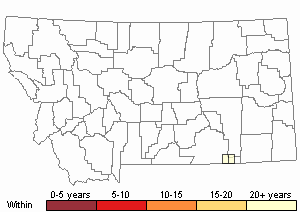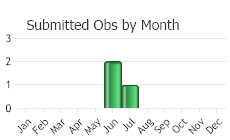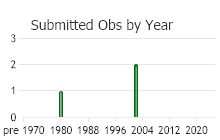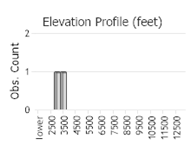View in other NatureServe Network Field Guides
NatureServe
Montana
Utah
Wyoming
Idaho
Wisconsin
British Columbia
South Carolina
Yukon
California
New York
Nuttall Desert-parsley - Lomatium nuttallii
State Rank Reason (see State Rank above)
The few populations of Nuttall's desert-parsley in the upper Tongue River drainage of Montana are disjunct from the main range of the species in southeastern Wyoming and adjacent Nebraska and Colorado. Its position on mid and lower slopes along drainages in conjunction with its occurrence on private land may make it susceptible to negative impacts from development activities. Potential future coal and/or coalbed methane development could eventually impact the species. Weeds are not currently a problem at any of the known sites. Additional locations are likely to be found in the vicinity of the known occurrences with additional surveys.
- Details on Status Ranking and Review
Population Size
Score3 - Vey Small: Generally <2,000 individuals.
CommentPopulation numbers are likely higher than what the current and limited survey data have documented.
Range Extent
Score1 - Peripheral, Disjunct or Sporadic Distribution in MT: Widespread species that is peripheral, disjunct or sporadically distributed within MT such that it occurs in <5% of the state (<7,500 sq. miles or the combined area of Beaverhead and Ravalli Counties) or is restricted to 4-5 sub-basins.
Area of Occupancy
Score3 - Very Low: Generally occurring in 3 or fewer Subwatersheds (6th Code HUC’s).
CommentAdditional locations likely exist as much suitable habitat in the area has not been surveyed.
Environmental Specificity
Score1 - Moderate: Species is restricted to a specific habitat that is more widely distributed or to several restricted habitats and is typically dependent upon relatively unaltered, good-quality habitat (C Values of 5-7).
Trends
Score0-1 - Stable to Minor Declines:
CommentTrends are undocumented, but it appears to be unlikely that the species is experiencing significant declines. Habitat is largely intact at this time.
Threats
Score2 - High: 31-70% of the populations are being negatively impacted or are likely to be impacted by one or more activities or agents, which are expected to result in decreased populations and/or habitat quality and/or quantity.
CommentPrimary threats are from energy development and related activities.
Intrinsic Vulnerability
Score0-1 - Low to Moderate Vulnerability.
Raw Conservation Status Score
Score
10 to 12 total points scored out of a possible 19.
General Description
Nuttall Desert-parsley is an aromatic, glabrous, perennial herb which stands 1-4 dm tall and which arises from a branched, thickened rootstock that is covered with old leaf bases. The leaves are all basal and are once or twice pinnately compound or three parted. The leaf blades are 2-15 cm long with ultimate linear divisions that are 10-45 mm long and 1-2 mm wide. The leaf petioles are expanded and sheathing at the base. Several to many small flowers are borne in flat-topped compound umbels on stout, leafless flower stems which are generally taller than the leaves. There are involucels of united or separate linear segments which subtend umbelets and often extend beyond the flowers. Flowers have 5 yellow petals and 5 stamens attached above a single two-chambered pistil with two styles. The mature fruits are flattened and narrowly oval-shaped with marginal wings and low ribs on the flat faces; they are 9-13 mm long and 3-4 mm wide.
Phenology
Flowering is usually in June, with fruits produced by July.
Diagnostic Characteristics
Lomatium triternatum and L. ambiguum also have linear leaflets, but do not have persistent old, stiff leaf bases. Another similar species known from Wyoming, L. graveolens (king desert-parsley), is best separated by the larger fruits (10-13 mm), longer fruiting pedicels (2-7 mm), and a notably malodorous smell. Cymopterus hendersonii has a similar growth form with old leaf bases but has fruits with wavy, winged ribs.
Species Range
Montana Range
Range Descriptions

 Native
Native
Range Comments
MT to NE, WY, UT. Known from Bighorn and Rosebud counties (Lesica et al. 2012. Manual of Montana Vascular Plants. BRIT Press. Fort Worth, TX).
Observations in Montana Natural Heritage Program Database
Number of Observations: 3
(Click on the following maps and charts to see full sized version)
Map Help and Descriptions
Relative Density

Recency



 (Observations spanning multiple months or years are excluded from time charts)
(Observations spanning multiple months or years are excluded from time charts)
Habitat
Nuttall's desert-parsley grows on open, rocky mid- and lower-slopes on sandstone, siltstone or clayey shale, in open pine woodlands from about 3400 to 7200 feet elevation. The vegetation is generally sparse, and commonly includes ponderosa pine, Rocky Mountain juniper, bluebunch wheatgrass, western wheatgrass, big sagebrush, and rubber-rabbitbrush (Ericameria nauseosa or Chrysothamnus nauseosus) (Barton & Crispin 2003).
National Vegetation Classification System Groups Associated with this Species
Forest and Woodland
Low Elevation - Xeric Forest and Woodland
Montane - Subalpine Forest and Woodland
Shrubland
Sagebrush Shrubland
Sparse and Barren
Sparse and Barren
Ecology
Montana populations have been found in or closely bordering drainages, implying a possible association with the availability of soil moisture that can be taken up and stored by the long taproots. One population was found in a stream channel, which would likely be subject to the scouring effects of runoff associated with a heavy rain (Barton & Crispin 2003).
Management
Nuttall's desert-parsley grows on mid- to lower-slopes, especially along drainages, and therefore could be vulnerable to extractive development.
Stewardship Responsibility
Threats or Limiting Factors
STATE THREAT SCORE REASON
Reported threats to Montana's populations of Nuttall Desert-parsley are those that affect its restricted habitat along drainage slopes of the upper Tongue River (MTNHP Threat Assessment 2021). Found between mid and lower slopes, usually on private lands, Nuttall Desert-parsley habitat is potentially valued by coal and methane gas industries for development activities. Plant damage and mortality from intense livestock grazing and trampling threatens populations and is likely to have indirect negative impacts to habitat quality. Exotic species also occur at some populations, where competition is likely to stress Nuttall’s Desert-parsley, and potential for exotic plants to spread is a concern.
References
- Literature Cited AboveLegend:
 View Online Publication
View Online Publication Lesica, P., M.T. Lavin, and P.F. Stickney. 2012. Manual of Montana Vascular Plants. Fort Worth, TX: BRIT Press. viii + 771 p.
Lesica, P., M.T. Lavin, and P.F. Stickney. 2012. Manual of Montana Vascular Plants. Fort Worth, TX: BRIT Press. viii + 771 p. MTNHP Threat Assessment. 2021. State Threat Score Assignment and Assessment of Reported Threats from 2006 to 2021 for State-listed Vascular Plants. Botany Program, Montana Natural Heritage Program, Helena, Montana.
MTNHP Threat Assessment. 2021. State Threat Score Assignment and Assessment of Reported Threats from 2006 to 2021 for State-listed Vascular Plants. Botany Program, Montana Natural Heritage Program, Helena, Montana.
- Additional ReferencesLegend:
 View Online Publication
View Online Publication
Do you know of a citation we're missing? Barton, D. and S. Crispin. 2003. Globally significant plants in southeastern Big Horn and southwestern Rosebud Counties, Montana. Prepared for the Bureau of Land Management. Montana Natural Heritage Program, Helena, Montana. 26 pp. plus appendices.
Barton, D. and S. Crispin. 2003. Globally significant plants in southeastern Big Horn and southwestern Rosebud Counties, Montana. Prepared for the Bureau of Land Management. Montana Natural Heritage Program, Helena, Montana. 26 pp. plus appendices. Lesica, P., M.T. Lavin, and P.F. Stickney. 2022. Manual of Montana Vascular Plants, Second Edition. Fort Worth, TX: BRIT Press. viii + 779 p.
Lesica, P., M.T. Lavin, and P.F. Stickney. 2022. Manual of Montana Vascular Plants, Second Edition. Fort Worth, TX: BRIT Press. viii + 779 p. Lesica, P., P. Husby, and S. V. Cooper. 1998. Noteworthy collections: Montana. Madrono 45:328-330.
Lesica, P., P. Husby, and S. V. Cooper. 1998. Noteworthy collections: Montana. Madrono 45:328-330. Mathias, M.E. 1938. A revision of the genus Lomatium. Annals of the Missouri Botanical Gardens 25:225-297.
Mathias, M.E. 1938. A revision of the genus Lomatium. Annals of the Missouri Botanical Gardens 25:225-297.
- Web Search Engines for Articles on "Nuttall Desert-parsley"





